We are family farms, built on family values
-
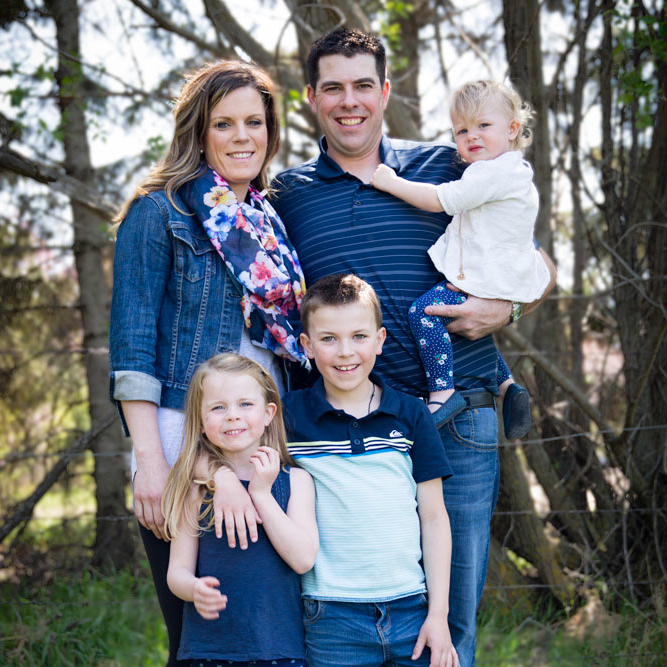
Meet Andre Poulin & Family
As a third-generation Canadian farmer, Andre Poulin obviously learned a lot as he grew up, through trying things for himself and from older members of the family.
-

Meet Sylvia Donkersgoed & Family
Sylvia runs her own diversified farm operation, not far from her brother's, in the southern part of Alberta.
-

Meet Erna Ference & Family
"It was a great transition", says Erna Ference of the decision her and her husband Reg made more than 20 years to leave the city and begin farming.
-
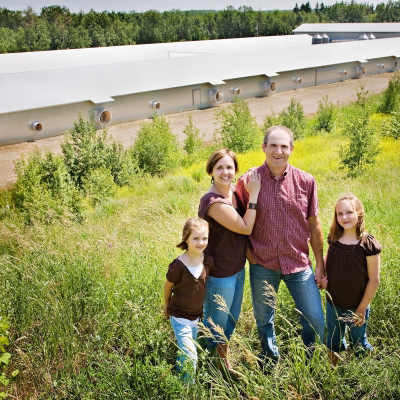
Meet Scott Wiens & Family
Scott farms near Edmonton, Alberta with his wife Susanne, and takes a great deal of pride in the quality of the birds raised by Canadian chicken farmers.
-
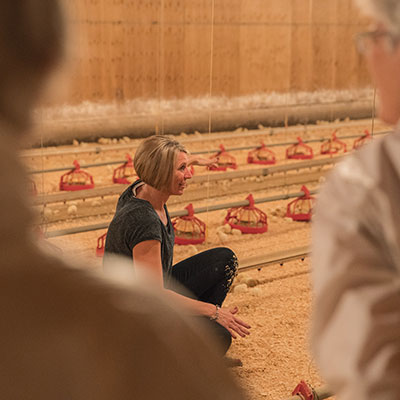
Meet Tara deVries & Family
It's difficult to sum up Tara deVries' involvement with the poultry industry. That said, one thing is certain - her passion for farming and for supporting agriculture is strong.
How are chickens raised in Alberta?
What does Raised by a Canadian Chicken Farmer mean?

On the Farm Food Safety
We believe that food safety begins on the farm. Chicken farmers across Canada follow an audited On Farm Food Safety Program (OFFSP). Our producers must comply with biosecurity, barn management and record-keeping requirements.
Producers undergo an annual audit by third-party professionals trained in HACCP principles and on-farm food safety and auditing techniques. Certification under the OFFSP program is a mandatory condition for a producer's license to market chicken in Alberta.
All registered chicken farmers in Alberta have been certified under the OFFSP Program since 2004.
Refer to forms area for associated fillable forms.
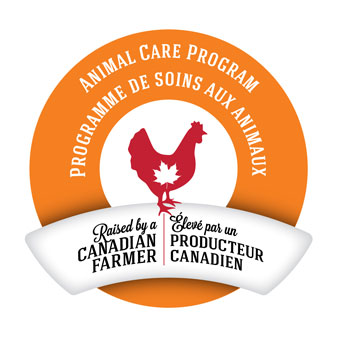
Animal Care Program
Alberta Chicken Producers is dedicated to ensuring that the stringent regulations related to the care and handling of our birds are met and followed. As part of this dedication, Alberta Chicken Producers implemented an auditable Animal Care Program to uphold the standards of the Canadian chicken industry’s on-farm animal care.
Certification under the Animal Care Program is a mandatory condition of a producer's license to market chicken in Alberta. All registered chicken farmers in Alberta have been certified under the Animal Care Program since 2012.
Refer to forms area for associated fillable forms.

Sustainability
CFC conducted an environmental life cycle assessment (LCA) of Canadian chicken in 2017 to benchmark and assess its environmental impact. The LCA reported the environmental footprint of Canadian chicken through three main indicators: carbon footprint, water consumption and non-renewable energy use.
Per kilogram of eviscerated chicken produced in Canada, on average:
- 2.4 kg of CO2 eq. is produced
- 65 L of water is consumed
- 25 MJ of non-renewable energy is consumed
Compared to other chicken-producing regions of the world, Canadian chicken has one of the lowest carbon footprints.
Farming FAQ
All antibiotics used are approved by Health Canada and/or are used in conjunction with a veterinary prescription.
CFC has banned the use of antibiotics obtained through the Own-Use Importation (OUI) provision and the use of Active Pharmaceutical Ingredients (API). CFC has eliminated the preventive use of Category I antibiotics – those most important to human health.
CFC’s On-Farm Food Safety Assurance Program has requirements for use; this program is audited annually and is mandatory in each Canadian province. Chicken Farmers also submit a flock sheet to processors and CFIA veterinarians for each flock processed, detailing the antibiotics that were used.
While farmers set the farm gate price, they do not set wholesale or retail prices. Grocery stores and restaurants set the market price based on what the market can bear.
Farm gate price is set in consultation with processors and considers costs of production and competitiveness. The farmer’s share is only a fraction of what is paid by consumers.
The price gap between Canadian and American products can be attributed to a variety of factors. On average, Canadians pay 23% more than Americans for ALL their goods and services. (source: OECD) In January 2013, the Globe and Mail commissioned a survey comparing 16 goods and services in Wal-Mart stores across the U.S. and in Canada, which found the same conclusion.
When Target announced the opening of its first stores in Canada, people expected the same prices as in the U.S. The President of Target Canada, Tony Fischer, explained why that wasn’t the case:
- Higher transportation and fuel costs
- Higher wages
- Lack of economies of scale
- Different and higher tax rates
The same reasons were cited in the Senate Committee on National Finance’s report to the Canada-USA Price Gap.
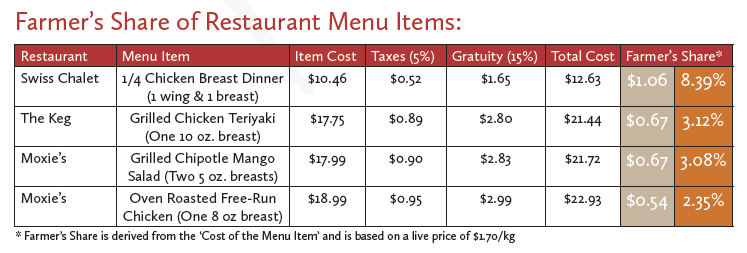
Chicken farmers take great care to raise their birds from the moment they arrive on the farm.
Chicks arrive at the farm as day-old birds and are placed into a barn that is maintained at 30 degrees Celsius. Fresh water and feed are made available so that they quickly start drinking and eating after a long trip. Right before hatching, chicks absorb the yolk sack in the egg which can sustain them for many hours until they reach their first meal.
As the birds grow, the temperature of the barn is decreased and their feed changes from a chick starter to a grower ration. Farmers may provide different rations as they grow to meet their nutritional and energy requirements.
Fresh feed and water is provided to the chickens through automated feed and water lines. The barn is kept at a comfortable temperature for the birds and proper air ventilation is maintained. If any of these systems malfunctions, the farmer is notified immediately and can quickly resolve the problem.
The birds take approximately 6-8 weeks to grow to attain their desired weight. Once they've reached market weight, they are loaded by ‘catchers’ onto transport trucks, and then delivered to the processor.
Farmers also monitor their flocks for health issues. Through biosecurity protocols, farmers can prevent the introduction of diseases from wild birds or other vectors. Farmers will often consult with a poultry veterinarian in the case of a health issue. Regulations are in place to ensure proper use of medications in flocks.
No. Hormones use in poultry production in Canada is illegal. In fact, it has been banned for over 50 years.
There are a lot of good reasons as to why hormones aren't used in poultry production.
Growth hormones aren't effective. It has been shown that giving growth hormones does not lead to increased growth in chickens. In a similar vein, injecting growth hormone into humans will not lead to development of a winning basketball team. Growth is an extremely complex combination of metabolic functions, depending on a wide array of endocrinological signals.
Administration of hormones would be extremely difficult. Growth hormone is a protein and if consumed orally, they would be quickly be digested in the same way as protein from corn or soy. Even if a positive effect were likely from growth hormone , it would need to be injected into chickens on a very frequent basis. The logistics of injecting hundreds of thousands of chickens with hormone illustrates the impossiblity of this scenario.
It would be expensive. Chicken growth hormone is not produced commercially, its cost would be extremely high. If one (1mg.) were to be administered to a broiler, the cost would be far in excess of the value of the chicken itself. Obviously, this makes no commercial sense.
Negative impact of chicken performance. The modern broiler has been genetically selected to grow rapidly and occasionally encounters physiological limits. Like humans, a “growth spurt” is usually accompanied by joint inflammation and other problems. Chicken farmers actually monitor, and sometimes limit growth rate and to decrease the incidence of lameness, heart attack and ascites. It would be highly counterproductive to suddenly force a higher rate of growth on broiler chickens.
Hormones are simply not needed. The rapid growth of broilers is very easy to explain without resorting to hormones. Through genetic selection for the past several decades, birds have reached a specified market weight one day earlier per year. The growth of modern broilers is a logical consequence of slow but consistent improvements in genetics, nutrition, management and disease control.
Reference: The University of Georgia, College of Agricultural and Environmental Sciences Cooperative Extension ~ Poultry Housing Tips
No. The birds are not confined, they are free to roam the barn.
The birds are raised in climate controlled barns to protect them from harsh winters, hot summers, predators and disease.
The chickens are bedded down with either straw or wood shavings. Chickens have access to fresh water and feed throughout the barn. Proper ventilation is important. Fans and air intakes draw fresh air through the barn.
Maintaining barn conditions is very important to the chicken farmer. If the temperature changes, or it a fan fails, farmers have an alert system that dials their cell phone to notify them if they are away from the barn. The comfort of the chickens is an important part of the Animal Care Program that all producers are required to be certified with.
Antibiotic use and resistance is a critical priority for the chicken industry in Canada. The responsible use of antibiotics, providing a safe food supply to consumers and maintaining high animal care program standards are all critical priorities.
Canadian Chicken Farmers are reducing the use of antibiotics most important to human health. CFC has implemented a policy that eliminated the preventive use of Category I antibiotics – those most important to human medicine. The preventative use of Category II antibiotics will be eliminated by the end of 2018 and the goal is to eliminate the preventive use of Category III antibiotics by the end of 2020.
Chicken Farmers of Canada (CFC) operates a HACCP-based program that standardizes on-farm food safety practices for food safety. The program is mandatory in all ten provinces. CFC is the first commodity in Canada to have received full recognized from the federal, provincial and territorial governments (led by the Canadian Food Inspection Agency) for its on-farm food safety program.
No. Consumers can be assured that poultry and eggs are free of antibiotic residues.
Testing has revealed no significant residue levels in over a decade. The Canadian Food Inspection Agency (CFIA) is involved in monitoring for antimicrobial residues and for monitoring antimicrobial use and withdrawal periods by way of the CFIA veterinarians at federal processing plants.
Federal regulations (i.e. CFIA Meat Hygiene Manual of Procedures, Chapter 19, section 3.4.2) require poultry farmers to report all antibiotics that have been used for each flock prior to the birds being processed. CFIA veterinarians verify these reports to determine that antibiotics were used as per their label or with a veterinary prescription and that the antibiotics are being used at the appropriate dosage for the appropriate application. Any product failing this investigation is not allowed on the market.
Antibiotic use and resistance is a critical priority for the chicken industry. The responsible use of antibiotics, providing a safe food supply to consumers and maintaining high animal care standards are all critical priorities.
Chicken Farmers of Canada is engaged in continuous education with farmers and stakeholders across Canada about the importance of antibiotics, the need for responsible use and the threat of antimicrobial resistance. CFC has actively been involved using veterinary epidemiologists and farmers while enforcing the principle of responsible antibiotic use and the potential for reduction strategies.
Chicken Farmers of Canada is actively involved in surveillance activities of antibiotic use and resistance in collaboration with the Public Health Agency of Canada. Results from these publically available reports will help inform further antibiotic use reduction policies by both government and industry.
Chicken Farmers of Canada are reducing the use of antibiotics most important to human health. CFC has implemented a new policy that eliminates the preventive use of Category I antibiotics – those most important to human medicine. More specifically, this policy eliminates the preventive use of Ceftiofur and Fluoroquinolones. Chicken Farmers of Canada is committed to examining further antibiotic reduction strategies where possible. Industry and federal government surveillance programs will help inform these decisions. CFC will continue to work closely with Health Canada and the Public Health Agency of Canada.
Chicken Farmers of Canada supports the removal of growth promotion claims from antibiotic labels.
Chicken Farmers of Canada is supportive of the governments’ efforts to close policy gaps for own-use importation and active pharmaceutical ingredients. In fact, CFC has prohibited the use of these loopholes in CFC’s On-Farm Food Safety Assurance Program. Chicken farmers do not “import truckloads of almost any antibiotics they like for use on their own animals, from anywhere in the world”.
Chicken Farmers of Canada operates a HACCP-based program that standardizes on-farm food safety practices for food safety. The program is mandatory in all 10 provinces. CFC is the first commodity in Canada to have received full recognized from the federal, provincial and territorial governments (led by the Canadian Food Inspection Agency) for its on-farm food safety program.
A number of resources are available on CFC’s website (www.chicken.ca ) that discuss antimicrobial use and resistance including information on the industry strategy; please feel free to refer to these at your convenience.
The European Union has not banned the use of antibiotics altogether.
Through a succession of bans, the European Union banned the majority of all feed antibiotics used for livestock agriculture. This is not a full ban on antibiotics, as antibiotics to cure sick birds are needed and are still allowed to be used. This approach has reduced the overall amount of medications being used, but they have removed drugs that had little or no use in human medicine. As a result of the ban, there has been a significant increase in the amount of antibiotics used in birds that are closer to the ones associated with human medicine, specifically fluoroquinolones and macrolides.
Canada (and North America) are taking a different approach by focusing on those antibiotics most critical to human health.
Alberta Agriculture and Rural Development has provided the following document for reference:
**NOTE** Many municipalities have bylaws regarding raising chickens within city/town limits. Check with your local city/town to find out what bylaws apply. You must also talk to your municipality regarding proper disposal of carcasses.
Processing Plants - To find a provincially inspected processing plant near you, please contact the government of Alberta's Ag-Info Centre at 310-FARM (310-3276).
We think the chicken came first, and we’re not the only ones. In a scientific report published in 2010, a group of British scientists concluded that only a chicken could produce the eggshell protein used to make a chicken egg, and therefore, the chicken must have come first.
A broiler chicken is the term used to describe a chicken raised for meat.
The majority of chickens raised for their meat in Canada are cross breeds based on the Plymouth White Rock and the Cornish White. Some specialty breeds such as Silkies and Taiwanese Chickens are also raised for their meat.
Chickens stay clean and healthy by having dust baths! Dust baths are part of a bird’s natural preening and plumage maintenance that keeps feathers in top condition. The dust that is worked into the bird’s feathers will absorb excess oil to help keep the feathers from becoming greasy. The oil-soaked dust is then easily shed, keeping the feathers clean and flexible for more efficient insulation. Dry skin and other debris can also be removed with the excess dust.
Chickens are grain fed
July 15, 2016 Aline Porrior
What chickens are fed greatly affects their health, as well as the flavour and nutrition of the meat. Farmers are extremely aware of this and realize the importance of feeding their birds properly.
The make-up and amount of feed given to chicken is very important throughout the different stages of their growth cycle. In fact, it’s a science. Feed can be too high, or too low, in nutrients, affecting the birds’ growth. And the makeup of the feed varies, from province to province, and even from region to region, depending on what is most available. The feed mills follow strict guidelines, administered by the Canadian Food Inspection Agency (CFIA), that govern what ingredients can be used.
To learn more about chicken feed, hormones and steroids, read this What Chickens Eat document.
Chicken farmers work in the barns with their animals daily so the chickens are used to people.
To minimize the excitement of the chickens, attendants working with the same groups of chickens wear clothing of uniform appearance during the whole production cycle. Movement of people and equipment within the barns is kept quiet and smooth. Building alterations are avoided during the production cycle. It is highly recommended that workers, before entering a barn, give an early perceptible signal to the chickens to prevent their being startled. (One of the simplest signals to which chickens can become easily conditioned, is a consistent number of distinct knocks on the door just before entry.)
Producers are required manage manure according to provincial and municipal regulations.
Barns are cleaned out after each flock; and the barns and equipment are cleaned and disinfected. Alberta Agriculture provides guidelines for manure disposal and management, however producers must also follow the environmental regulations set out by both provincial and municipal governments regarding expansion of their operations, manure storage, transportation, and land application.
Chicken litter is a mix of manure and bedding material. It is a high quality source of nitrogen and carbon. The nitrogen is in solid form, contributing to its value as an excellent fertilizer for crops, gardens and composting. Most broiler producers in Alberta use the manure for their own farms or sell it to a neighbour for usage. Some farmers will sell it or use it on their farms as biomass fuel, while other farmers sell it for fertilizer production.
The meat manager at a retail grocery store or a chef in a restaurant would be able to identify the supplier.
Each package has a specific ‘code’ that identifies the processing plant. Traceability is not only important for determining the location in which the meat was produced but it is critical for ensuring food safety for consumers.
There are no visual or nutritional differences between two healthy chickens grown organically or commercially.
Organic chicken producers go through organic certification in order to label their chicken as organic. The meat manager at a retail grocery store or a chef in a restaurant would be able to tell you if the chicken is organic or not.
To purchase chicken directly, you may contact any of the following:
- Lilydale/Sofina 1-800-661-5341
- Maple Leaf (780) 417-4209
- Sunrise 1-800-567-6117
- High River Colony (403)536-2449 ext 301
- Jenner Colony (403) 898-3938 ext 142
- Lone Pine Colony (403) 742-3454 ext 274 or ext. 298
- Morinville Colony - (780)233-7949
- Warburg Colony (780)203-1933
- Vyefield Enterprises (403)669-0713
For Specialty Chicken:
- Taiwanese Chicken
- Alberta T.C.'s - (604)309-1878
- Halal Chicken
- Morinville Colony - (780)233-7949
- Vyefield Enterprises (403)669-0713
- Warburg Colony - (780)203-1933
Spent Fowl are laying hens older than 60 weeks that are a byproduct of the egg and hatching egg industries.
Spent fowl from other countries is not subject to import controls and it can’t be distinguished from the chicken produced by Canadian chicken farmers. These imports are displacing Canadian chicken production. It robs Canadian chicken farmers and processors of jobs and revenue.
106 million kg of spent fowl was imported in 2012 from the US. This is an increase of more than 50% in just 3 years. This resulted in 8,900 fewer jobs were created in Canada and $591 million less being contributed to the GDP by Canadian chicken farmers and processors.
Importers are blending 51% spent fowl with 49% non-domestic broiler meat to circumvent import controls. This is outright fraud. Canada is importing more spent fowl breast meat than is produced in the entire US. 74% of Canadians want spent fowl to be clearly labeled.
The regulation stipulates that you are allowed to raise 2,000 chickens per calendar year.
Use is restricted to personal consumption, sale to an adjacent neighbour, or for sale at farmer’s markets.
In order to produce more than 2000 broiler birds per year, a person must hold or lease quota.
Alberta Chicken Producers does not have a list of individuals interested in selling quota at any given time, however if we are notified we do run advertisements in our newsletters. You can access current and past issues of our newsletter here.
Is there arsenic in chickens or chicken feed?
Arsenic (Roxarsone) is not used in Canada, and levels of arsenic in chicken feed are not considered a cause for concern for human health in Canada. The Canadian Food Inspection Agency conducts annual monitoring for residue levels in poultry meat across Canada. Over many years, no violations involving arsenic were found. Regardless, Canada suspended all sales of the feed containing arsenic (Roxarsone) as of August 8, 2011, while further investigation takes place.
In the past, trace amounts of arsenic, an approved animal feed supplement, were occasionally included in some chicken feed to control intestinal parasites. These were usually only provided in the first part of a chicken's growth cycle.
A US company voluntarily made the decision to remove aresenic from chicken feed when extremely low residue levels of inorganic arsenic were discovered in the livers of treated chickens (not in the meat, but in the livers). This extremely low level was equivalent to the level of inorganic arsenic found in an eight-ounce glass of drinking water. Nevertheless, this level was higher than that found in untreated chickens, and this represented an avoidable exposure.
Arsenic is an odorless and tasteless element that occurs naturally in rocks, soil, water, air, plants and animals. Many foods naturally contain arsenic, including grains, meats, seafood, fruits, and vegetables. There are two types of arsenic – organic and inorganic. Arsenic levels in foods and drinking water are regulated by government to minimize avoidable exposure. In many cases, these levels are higher than the residue levels of inorganic arsenic found in chicken liver in the FDA study.
Like humans, chickens have different kinds of naturally occurring bacteria in their gut. In chickens, one of those types of bacteria is called Salmonella. People who eat food contaminated by certain strains of Salmonella can become ill with salmonellosis - although, not all Salmonella will make you sick. Poultry processing plants do a lot of work to prevent Salmonella contamination of chicken meat, but nothing can ever be 100 per cent effective. Luckily, any Salmonella bacteria that might have transferred onto raw chicken meat is killed when chicken is cooked properly. You can find more information on Salmonella and salmonellosis on the Public Health Agency of Canada's website .
Concerned about antibiotic resistance and use?
We are too. Check out this short video we’ve put together to talk about the issue and what chicken farmers are doing about it. And what you can do as well!

